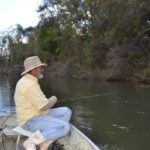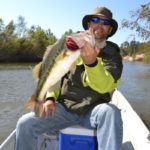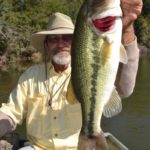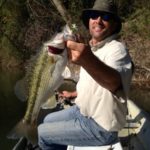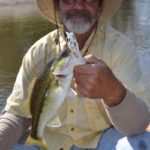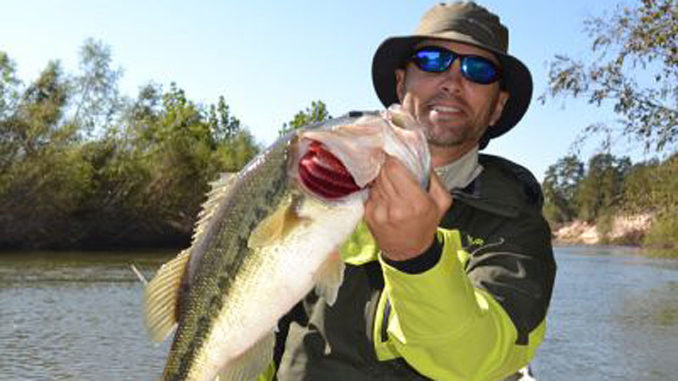
This angler lets the hunters have the woods. When the calendar turns from September to October, his heart draws him to the Florida Parishes’ rivers.
Joe Lavigne saw more deer than probably half the Louisiana hunters who had humped their way up trees one morning last October.
But the two does and two yearlings had nothing to fear from Lavigne.
Under different circumstances, that might not have been true. Lavigne is an avid outdoorsman, and that includes targeting whitetails with a bow, crossbow and high-powered rifle.
But in Lavigne’s hands that day was something far less disconcerting to the average skillet-head: a 6-foot rod and baitcasting reel.
Lavigne was doing what he always does this time of year, when the stable air of fall drops the rainfall levels to something you’d never expect to see in our subtropical climate.
When the autumn is dry, the rivers that run like ribbons throughout the Florida Parishes get low, slow and absolutely gorgeous.
Around the end of August last year, it looked like that might never happen. Hurricane Isaac had dumped record levels of rain across Southeast Louisiana and southern Mississippi, and the rivers got higher than the 63-year-old Lavigne had ever seen them.
Even at that height, Lavigne’s favorite river, the Tangipahoa, was in danger of climbing another 5 feet after the near failure of a dam at Percy Quinn State Park near McComb, Miss.
Fortunately, the dam held, but it still looked like the water that was left would take six months to follow the path of the river out to Lakes Maurepas and Pontchartrain.
But toward the end of October, the rivers started looking right to Lavigne, who checks them nearly every day, so he made a three-hour float on the Tangipahoa, and caught his limit of spotted bass.
He went again the next day, and picked up another limit.
He invited me to tag along on the following day’s trip, and I wouldn’t have missed it for another Saints Super Bowl.
Fishing these rivers is cathartic. Put trolling for marlin during a tropical storm at one end of the spectrum. Floating Lake Pontchartrain’s northshore rivers for Kentucky bass is at the other end.
The rivers rage in spots. Wherever stubborn bluffs squeeze the water, it races to get by. Add in blowdowns and gravel bars, and you have the Louisiana version of rapids.
In other areas, the river gets wide, sloppy and lazy. There’s a current, sure, but it’s like what you’d find during a neap tide in the marshes of Lafitte.
Lavigne fishes it all while perched on the front seat of his 12-foot ultralight aluminum flat. The boat has more dents than a golf ball, and its bottom has been worn thin and polished to a mirror shine by 42 billion trips over gravel and sandbars.
Lavigne sits on a throwable seat cushion to delay the onset of “pirogue ass,” and he sports Cajun Reeboks, known across the rest of America as white shrimp boots.
His trolling motor looks conspicuously like his two arms, which Lavigne uses to scull the boat with a short paddle around blowdowns and over to the more-productive bank — always the one on the outside of a bend.
In all but the unusually straight sections of the river, one bank will be immediately adjacent to deep water while the other will slope out slowly.
Without exception, Lavigne ignores the flat banks. They’re virtually fishless.
“Most days, I can tell you with 100-percent certainty which spots will hold fish,” he said. “After you fish these rivers a few times, you learn what spots you should throw to and which spots you can forget about.”
Lavigne makes casts that are remarkably precise, and his most-productive ones are under overhanging branches or into pockets of “dead water.”
Everything in a river tends to point downcurrent, so many of Lavigne’s casts into dead water occur after he has passed up the structure and gained an angle into the honey hole.
“You’ve got to be able to cast,” he said. “You’ve got to cast very well on the river.
“Most of your good fishermen can cast pretty good, but I’ll throw it anywhere.”
He frequently casts over logs that are in the river parallel to the river bank. Many times, he pulls bass over these logs. Sometimes he doesn’t.
“Yesterday, I had a 3-pound Kentucky, and I had thrown over a limb about 2 feet out of the water,” Lavigne said. “I hooked him, and got him up halfway.
“I couldn’t get him over, and I couldn’t get the boat there, and he finally got off. But, hey, that’s the fun of it.”
What exactly Lavigne throws depends on the time of year and the conditions, but he definitely has a favorite.
“The Humdinger spinnerbait is pretty much your go-to bait now,” Lavigne said. “I also use Horny Toads. You get a lot of strikes on a Horny Toad, but you miss a lot.
“Topwater in the spring is really good. If you can catch the river clear, which you very seldom do in the spring, you can really do well on topwater.”
In addition to the Humdingers in the fall, Lavigne also throws Devil’s Horses, Rebel Wee Craws and frog-colored Tiny Torpedoes.
The autumn is, far and away, Lavigne’s favorite time to fish the rivers. The fish seem rejuvenated after the blistering temperatures of summer, and the high water levels and turbidity from summer thunderstorms have protected them from human predation.
Also, many other “river rats” are focused on hunting and couldn’t care less about chasing anything without fur or feathers.
So Lavigne usually has the river all to himself. If he’s fishing solo, he’ll have his wife drop him off at one point in the river, and pick him up X hours later at a designated point downstream. Lavigne has learned the rivers well enough to know precisely how long each float should take.
If he’s fishing with a partner, they’ll leave one truck at the takeout point, and use the other to get to the put-in spot. After the trip, they’ll drive back up to the upriver truck.
Lavigne doesn’t bust his butt to get to the river early this time of year.
“A lot of times, these fish bite best in the middle of the day,” he said. “I like putting in around 9 a.m., and I’ll catch my fish anywhere from then to about 3 or 4 o’clock.”
During my trip with Lavigne, we caught 80 bass, counting some little peanuts, but we still had 10- or 15-minute lulls without any bites. That’s always going to happen, Lavigne said, but the fall fishing is so good that no lull lasts for very long.
“On the two trips before this one, I had one or two fish the first hour, and then it was like that alarm went off,” he said.
Some of the fish, as mentioned, are small. Kentucky bass are insanely feisty, and little tykes don’t seem to care that a particular bait is half their size.
But the rivers also hold some really beautiful fish. On my trip with Lavigne, eight of the Kentucky bass we caught were over 2 pounds, and I also boated a 23-inch, 5-pound largemouth.
That’s a true river trophy.
“You’ll catch one largemouth out of every 30 or so bass,” Lavigne said. “That particular fish probably came out of a dead lake or possibly a pond. There are very few largemouths caught (on the rivers). On the last two trips, we caught a total of two largemouths.”
But the real draw for Lavigne is the high number of red-eyed Kentucky bass these rivers hold. The fish are ferociously powerful and fearless. They’re chock full of attitude, probably gained from a lifetime of battling raging river currents.
Hook a 2-pound Kentucky, and you’ll swear it could beat the living crap out of a 4-pound redfish. Get it in the boat, and you’ll just about need a fish billy to subdue it.
Lavigne loves the species, and he can’t get enough of them. That’s why he checks the Tangipahoa River near his Independence home nearly every day, just waiting for it to get right.
But if it’s not right, he doesn’t go.
“I’ve learned,” he said. “I’ve tried to press the issue and fished when it wasn’t clear, and you know, you’ll catch a handful of fish, but it has to be clear to be good.”
And if it’s dry and it’s October, it’ll be clear.
